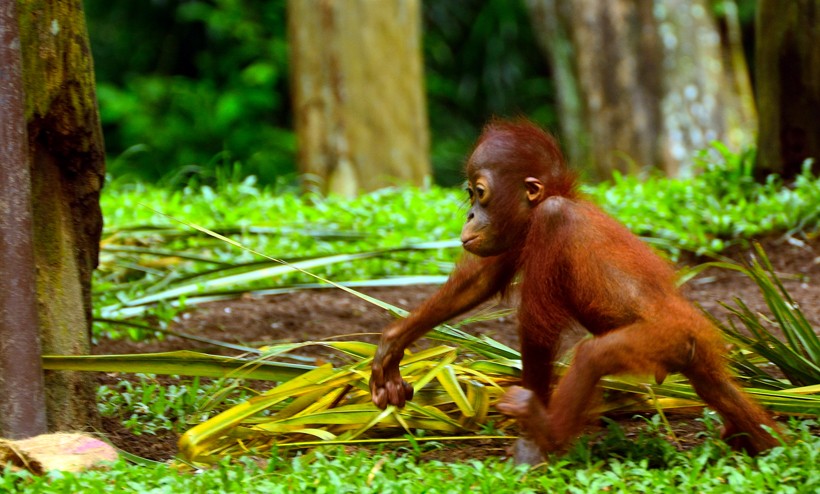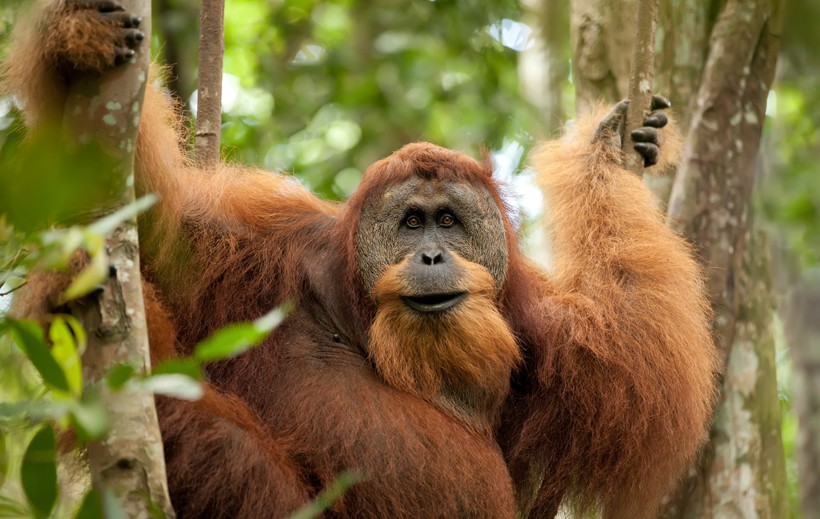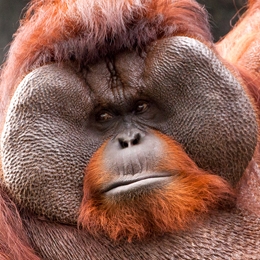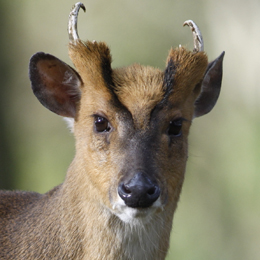Description
Fondly known as the Red Apes, Sumatran orangutans are the long, red-orange haired primates of Asia. In the Malay language, "orang" means person and "hutan" means forest. So, orangutan literally means "person of the forest". Once orangutans were found in most parts of Southeast Asia. Nowadays they are restricted to just two places: Sumatra and Borneo.
Sumatran orangutans are large primates with an average size of 1.25-1.5 m (4-5 ft), and an average weight of 30-82 kg (66-180 lb). Male Sumatran orangutans are larger, measuring around 1.4 m (4.6 ft) whereas their female counterparts are around 90 cm (3.0 ft) on an average. The average weight of females ranges from 30 to 50 kg whereas males weigh around 50 to 90 kg.

Sumatran orangutans are also known as red apes
?
Image credits: Michael Steden/Shutterstock
Another difference between males and females, besides weight and size, is that males have huge cheek pads with fine white hairs. In some males, the cheek flanges and muscle mass are either not developed or the development of it starts later. Females prefer flanged males for mating. However, smaller or unflanged males are also capable of reproducing by employing a different mating strategy.
Since these primates share 97% of their DNA with humans, they have senses that are very similar to that of humans. Their senses of sight, taste, hearing and touch are pretty much like ours. Also, they are a highly intelligent species. The life span of Sumatran orangutans is long, typically between 30 and 40 years.
Sumatran vs Bornean Orangutan
Orangutans belong to the great apes species that are exclusive to Asia. At one time, the entire Southeast Asia was home to these primates. However, nowadays they are found in only two places: Borneo and Sumatra. At first, the orangutans from Borneo and Sumatra were classified as a single species. Today they are considered as two distinct species of genus Pongo. Although both from the same genus, Borneo and Sumatran orangutans have a few dissimilarities.
To start with, Borneo orangutans (Pongo pygmaeus) are found on the island of Borneo, an island that is shared by Malaysia, Indonesia and Brunei. Sumatran orangutans (Pongo abelii) are natives of the island of Sumatra in Indonesia. Sumatran orangutans are rarer than Borneo orangutans. Only 7,500 Sumatran orangutans are left compared to 45,000 Bornean orangutans in the wild.

Being primarily arboreal primates, Sumatran orangutans spend most of their lives in trees.
?
Image credits: Denys Kutsevalov/Shutterstock
There are several physical appearance differences between these two species. The beards of Sumatran orangutans are longer than that of Bornean orangutans. They also have smaller statures and smaller flanges covered with fine hairs when compared to their Bornean counterparts. The Bornean species has a more heavy set and is darker haired than the Sumatran species. The cheek pads of male Sumatran orangutans are less pronounced than that of their cousins.
As far as their way of living concerns, Sumatran orangutans are normally exclusively arboreal and seldom descend to the ground. However, sometimes males grow too big to live and move easily through the trees, the reason why they are observed sometimes walking on the ground. While also being arboreal, male Bornean orangutans may be seen on the ground quite often. As far as their behavior goes, Sumatran natives are more social than Bornean natives and share strong social bonds with other Sumatran orangutans.
Unfortunately, both orangutan species are considered critically endangered. Unless we take the necessary conservation steps, their population sizes will keep declining.
Anatomy and Characteristics
Sumatran orangutans have longer fur, longer beards and more slender bodies than Bornean orangutans. They have fine red hairs on their bodies and fine white hairs on their faces and groin areas. Males have prominent cheek pads that also possess white hairs, resembling a beard. However, these cheek pads are not as prominent as that of male Bornean orangutans.

Female sumatran orangutan
?
Image credits: neelsky/Shutterstock
As the largest arboreal mammals, Sumatran orangutans have various adaptations that support their tree-dwelling lifestyle. One of the most striking characteristics of Sumatran orangutans is their huge arm span that is approximately 2.25 m from finger tip to finger tip. The arms are much longer and more muscular than the legs and help them swing from one branch to the other. They have incredible agile and dextrous hands and feet. The hands and feet are also capable of maintaining tight grips for short periods. Like human beings, Sumatran orangutans have opposable thumbs to pick and peel fruits. Having sharp and strong teeth, they tear and grind their food.
Sumatran orangutans have five life stages with different physical characteristics. Let’s take a look at these stages.
During their infancy period (birth to 2.5 years), orangutans weigh around 6 kg and have light pigmented areas around their eyes and muzzles. These areas are in contrast to their darker faces. They have long hair on their faces that protrude outwards.
In their juvenile stage (2.5 to 5 years), orangutans weigh around 15 kg and look similar to infants. There are only marginal differences in appearance between infants and juvenile Sumatran orangutans.
In their adolescence period (5 to 8 years), the weight is around 30 kg and a few physical changes in their appearance occur. The light patches on their face disappear gradually and the face becomes darker.
In their sub-adulthood phase (8 to 13 years), orangutans weigh about 50 kg and the face becomes completely dark. Males start to develop cheek flanges. Beard-like features begin to emerge around their faces. Facial hair become short and flatten around the skull. This stage is the onset of sexual maturity among males.
When adult (from 13 to 15 years onwards), male Sumatran orangutans weigh around 90 kg and fully grown out. They have grown beards, long hair and fully-developed cheek flanges.
Habitat
Red apes are primarily found in the tropical rain forests, and live, with the exception of too heavy males, solely in the trees. They build nests high in the canopies by folding tree branches. These nests are used for taking naps and sleep during the night. Their preferred elevations are about 200 to 400 m and preferred areas depends on the location of their favorite fruiting trees. Despite their preference, Sumatran orangutans have been observed also at elevations of about 1,000 to 2,000 m.

Sumatran orangutan in the jungle of sumatra
?
Image credits: Shanti Hesse/Shutterstock
Pongo abelii were found once all over the island of Sumatra in Indonesia. However, nowadays their habitat is restricted to the northern parts of the island. The wild Sumatran orangutan population can be found in just one province of the northern tip of Sumatra where they live in the humid, dense tropical rain forests. Since they rely heavily on the surrounding forests for their survival, Sumatran orangutans are majorly affected by habitat loss.
Diet & Predators
The food choices of Sumatran orangutans vary by season. Fruits are available in a particular season and in a limited range. These mammals stay close to the fruiting trees and feed on fruits whenever ripe. The orangutans may travel for miles in search of food. Their dextrous and agile fingers help them to pick and peel ripe as well as unripe fruits.
When the fruit availability is marginal, they consume other vegetation. However, fruits make 60% of their diet with figs being their favorite. They also eat young leaves, tree barks and flowers. Under extreme conditions, Sumatran orangutans prey on slow loris, crickets, ants, termites and birds' eggs. Although most of the liquid is taken from their food, they have been seen drinking also from water sources. They cup their hands to collect water for drinking.
The natural predators of Sumatran orangutans include clouded leopards and Sumatran tigers. However, their biggest threat comes from human beings.
Reproduction and Life Cycle
Did you know that the mating strategy for Sumatran orangutans involves harassment of the females? Yes, estrous females are "harassed" by unflanged as well as flanged males. Most of the harassment is coming from unflanged males as females prefer flanged ones (the larger the better). Sub-adult unflanged males may corner females and even resort to forceful copulation. These males may take away the offspring of females to make them more willing and available for mating.

Sumatran orangutan mother and child
?
Image credits: Shanti Hesse/Shutterstock
Once females understand this mating strategy, they avoid sub-adult mates through social tactics. Females take protection from adult male Sumatran orangutans or form alliances with other females to protect themselves from the sub-adults.
Heavy fruiting months results in a higher mating rate. However, the rain season, from December to May, is the most ideal period for mating. Sumatran orangutans mate most intensely during the mast fruiting years when trees bear fruits at the same time. This occurs once in two to ten years.

Sumatran orangutan young walking in the jungle
?
Image credits: Attila JANDI/Shutterstock
Sumatran orangutans follow a polygynandrous mating system (both male and female mate with several counterparts). Mating takes place between females who are not caring for offspring and large adult males in the area. The sexual maturity is attained around 12-15 years of ages. Females mature between the ages of 9 and 15 whereas males mature around 16 to 18 years. The first offspring is produced soon after the female becomes sexually active.
After a gestation period of 9 months, the female gives birth to typically one infant and rarely twins. The birth takes place in the nest constructed by the mother in a tree top. Infants cling to their mother for safety and don't leave her for the first few years of their life. Although they are weaned for about 3 years, they continue to remain with their mother.

Mother sumatran orangutan carrying infant
?
Image credits: Attila JANDI/Shutterstock
Till 8 to 9 years after birth, females are busy with their parental responsibilities. Infants and juveniles learn social behaviors, survival tactics and feeding habits from their mother. Males play no major role in raising offspring. Mothers provide food to their infants and juveniles until they are able to take care for their own. Fully grown out males leave their mother to establish their own territories. Independent young females typically live near their mothers' territories.
The inter-birth intervals among Sumatran orangutans are the longest found in the group of great apes. The average interval is around 9 years, making it difficult to increase their population size. A menopause among females is not observed.
Behavior, Communication & Intelligence
Being primarily arboreal primates, Sumatran orangutans spend most of their lives in trees. Extremely large males walk on the ground as the trees cannot bear their weight. Young orangutans move from one branch to another by swinging with their long, strong arms. However, this arm swinging movement cannot be followed by older, larger orangutans because of their weight.
These mammals are active during the daytime - searching for food and building nests in tree tops. Bent branches, leaves and sticks are used to construct these nests.
Sumatran orangutans are territorial and protect their territories against intruders. The territory of males usually includes the territories of three females. Adult flanged males enjoy the right to mate with the females within their territories.

Being primarily arboreal primates, Sumatran orangutans spend most of their lives in trees.
?
Image credits: Stephane Bidouze/Shutterstock
Orangutans of Sumatra are more social and spend more time in smaller groups than the orangutans from Borneo. One major way of social interaction is grooming. Solitary grooming has also been observed among these primates. Females within groups scratch and preen each other. The grooming between mothers and their offspring includes cutting of fingernails and toenails with teeth. Most grooming is done by mouth and not hands. During self-grooming, Sumatran orangutans use their mouth and lips to flip through their hair.
Social and non-social play is observed among adults and juveniles. Young orangutans are very playful and which includes also non-aggressive biting. Sometimes they use body language to play with their peers instead of physical contact. Thanks to their flexible lips, Sumatran orangutans are capable of showing a variety of facial expressions. Like their Borneo cousin, Sumatran orangutans are a highly intelligent species, capable of learning language and complex tasks. Tool usage is also prominent among Sumatran orangutans. It has been observed that they are using sticks to measure water depth and for acquiring seeds. Leaves are used to alter their calls, whereas branches are used to forage for food.
The loud calls of male Sumatran orangutans, also known as long calls, can be heard echoing in the forests, even from a distance of 1 km. The calls, consisting a series of sounds, are used to claim the male territory, warn and keep possible intruders outside their territory and to communicate with females. Young orangutans squeak, scream and bark whereas adults grumble and grunt. They make a wide range of sounds using their throats and lips.
Population and Conservation Status
As per one of the surveys, there are about 7,500 individuals left in the wild. Sumatran orangutans are hunted for their meat and females are killed to take away infants for illegal pet trades. Hunting and illegal pet trade have resulted in a 30 to 50% decline of the red apes population. That's why they have been listed as a critically endangered species.
These primates play a vital role in the ecosystem and are considered as keystone species. They disperse seeds and maintain balance in the rainforest. As they typically eat stalks and leaves, Sumatran orangutans contribute to pruning and regenerating of plant growth. Protection of these orangutans is, therefore, essential for a sustainable ecosystem.

The sumatran orangutan is a critically endangered species
?
Image credits: Eugene Sim/Shutterstock
Currently, the government agencies are making efforts to conserve this species by protecting their habitat and rehabilitating ex-captives and displaced individuals. It is essential to take proactive measures to help these primates to survive and even to let them thrive.
Evolutionary History
According to certain studies, orangutans might have walked on earth for around 2 million years. The old world monkeys and apes were regarded as one group until 25 million years ago. Later on, they split in two independent categories. The great apes might have evolved from small apes.
The collected fossils of Sivapithecus species, that were excavated in Turkey, Pakistan and China, suggest that their bone structure helped them to walk on land as well as dwell in trees. The diet of Sivapithecus was comprised of seeds and grasses. It is believed that Sivapithecus might have been the ancestral animal of orangutans. It was about 400,000 years ago that Bornean orangutans separated from Sumatran orangutans.
Funfacts
- Sumatran orangutans along with Bornean orangutans are the only great apes found outside the continent of Africa.
- Mosquitoes disturb orangutans just as they disturb human beings.
- Sumatran orangutans have the longest birth intervals among mammals.



